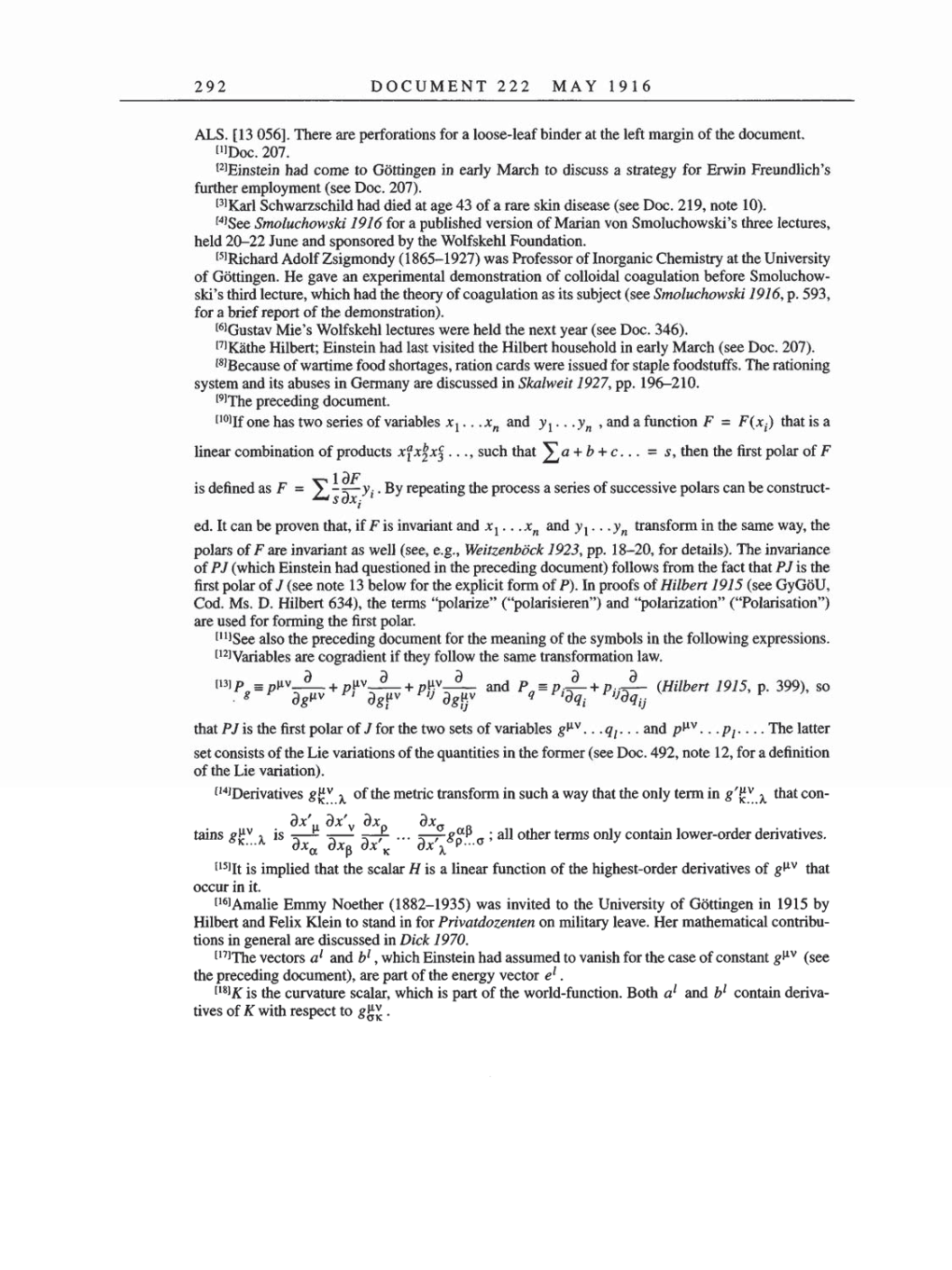292 DOCUMENT 222 MAY 1916
ALS.
[13 056].
There
are perforations
for
a
loose-leaf
binder at the
left
margin
of
the
document.
[1]Doc.
207.
[2]Einstein had
come
to
Göttingen
in
early
March
to
discuss
a strategy
for
Erwin Freundlich’s
further
employment
(see
Doc.
207).
[3]Karl
Schwarzschild
had died at
age
43
of
a
rare
skin disease
(see
Doc.
219,
note
10).
[4]See
Smoluchowski
1916
for
a published
version of
Marian
von
Smoluchowski’s three
lectures,
held 20-22 June
and
sponsored by
the Wolfskehl Foundation.
[5]Richard Adolf
Zsigmondy
(1865-1927)
was
Professor of
Inorganic
Chemistry
at the
University
of
Göttingen.
He
gave
an
experimental
demonstration of
colloidal
coagulation
before
Smoluchow-
ski’s third
lecture,
which
had the
theory
of
coagulation as
its
subject (see
Smoluchowski
1916,
p.
593,
for
a
brief
report
of
the
demonstration).
[6]Gustav
Mie’s Wolfskehl lectures
were
held the
next
year (see
Doc.
346).
[7]Käthe Hilbert;
Einstein had
last
visited the
Hilbert
household in
early
March
(see
Doc.
207).
[8]Because
of
wartime food
shortages,
ration cards
were
issued for
staple
foodstuffs. The
rationing
system
and its abuses in
Germany
are
discussed in Skalweit
1927,
pp.
196-210.
[9]The preceding
document.
[10]If one
has two series
of
variables x1...xn
and
y1...yn,
and
a
function F
=
F(xi)
that
is
a
linear
combination
of
products
xa1xb2xc3...,
such
that
Za+b+c...
=
s,
then the first
polar
of F
is defined
as
F
=
z1/sdF/dxiyi.
By repeating
the
process a
series
of
successive
polars can
be construct-
ed.
It
can
be
proven
that,
if F
is invariant and
x1...xn
and
y1...yn
transform
in the
same
way,
the
polars
of F
are
invariant
as
well
(see, e.g.,
Weitzenböck 1923,
pp.
18-20,
for
details).
The invariance
of PJ
(which
Einstein had
questioned
in
the
preceding document)
follows
from the
fact that
PJ
is
the
first
polar
of
J
(see
note 13
below
for
the
explicit
form of
P).
In
proofs
of Hilbert
1915
(see
GyGöU,
Cod.
Ms. D.
Hilbert
634),
the terms
“polarize” (“polarisieren”)
and
“polarization” (“Polarisation”)
are
used
for
forming
the
first
polar.
[11]See
also
the
preceding document for the meaning
of
the
symbols
in the
following expressions.
[12]Variables
are
cogradient
if
they
follow
the
same
transformation law.
[13]p
=
puvd/dguv
+
d
and
Pq
=
pi
d/dqi
+ p
*
(Hilbert
1915,
p.
399),
so
that
PJ
is
the first
polar
of J
for the two sets
of
variables
guv...ql...
and
puv...pi....
The latter
set consists
of
the Lie variations
of
the
quantities
in
the
former
(see
Doc. 492, note
12,
for
a
definition
of
the Lie
variation).
[14]Derivatives
guvy
of
the metric
transform
in such
a way
that the
only
term in
g'uvk...y
that
con-
tains
guvk...y
is
dx'u/dxa...dx'a-gaBp...o;
all other
terms
only
contain lower-order derivatives.
[15]It
is
implied
that the
scalar
H
is
a
linear
function of
the
highest-order
derivatives
of
guv
that
occur
in it.
[16]Amalie
Emmy
Noether
(1882-1935)
was
invited to the
University
of
Göttingen
in 1915
by
Hilbert and Felix Klein
to
stand in
for
Privatdozenten
on military
leave. Her mathematical contribu-
tions in
general are
discussed
in Dick 1970.
[17]The vectors
al
and
bl,
which Einstein
had
assumed to vanish for the
case
of
constant guv
(see
the
preceding
document), are part
of
the
energy
vector
el.
[18]K
is the curvature
scalar,
which is
part
of
the world-function.
Both al
and bl contain deriva-
tives
of
K with respect to
guvok.
